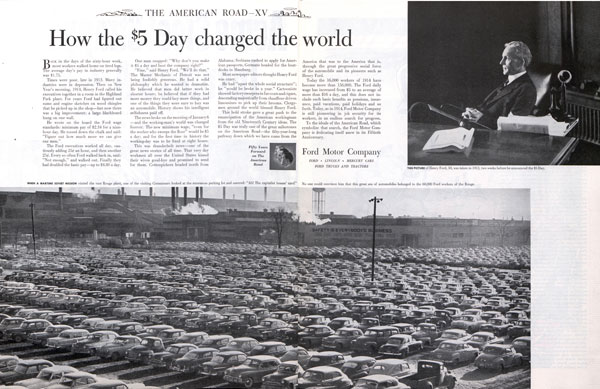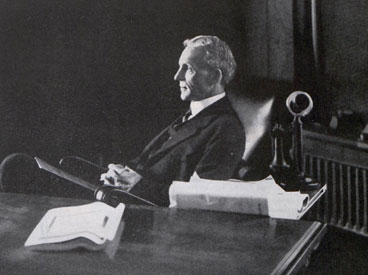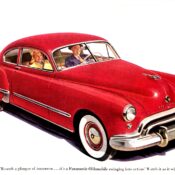
In 1914, Henry Ford made a big announcement that shocked the country. It caused the financial editor at The New York Times to stagger into the newsroom and ask his staff in a stunned whisper, “He’s crazy, isn’t he? Don’t you think he’s crazy?”
That morning, Ford would begin paying his employees $5.00 a day, over twice the average wage for automakers in 1914.
In addition, he was reducing the work day from 9 hours to 8 hours, a significant drop from the 60-hour work week that was the standard in American manufacturing.
According to an article (above) in the Post sponsored by the automaker, Ford arrived at the new wage scale during a meeting with his managers.
He wrote on the board the Ford wage standards: minimum pay of $2.34 for a nine-hour day. He tossed down the chalk and said: “Figure out how much more we can give our men.”
The Ford executives worked all day, cautiously adding 25¢ an hour, and then another 25¢. Every so often Ford walked back in, said: “Not enough,” and walked out.
Finally they had doubled the basic pay—up to $4.80 a day. One man snapped, “Why don’t you make it $5 a day and bust the company right?”
“Fine,” said Henry Ford. “We’ll do that.”
A young reporter from the Times travelled to Detroit to learn more about this revolutionary move. His name was Edward Peter Garrett, but he wrote under the name Garet Garrett, which was how Post readers knew him when he was the magazine’s financial writer between 1922 and 1942.
Arriving in Detroit, Garrett found the city’s manufacturers panicking and predicting various disasters. The higher wages would cause other employers to leave the city, they said. Carmakers who remained and tried to match Ford’s wages would go bankrupt. Ford employees would be “demoralized by this sudden affluence,” and, of course, Ford Motor Company would soon be bankrupt.
Fortunately, Garrett was able to get an audience with Henry Ford and, over the course of two days, discuss the company’s revolutionary changes. He wrote of his extended interview with Ford in a 1952 book, The Wild Wheel. He recalled asking Ford why he raised wages when every other manufacturer was trying to reduce wages to the lowest acceptable figure. Ford believed he was buying higher quality work from all his employees. “If the floor sweeper’s heart is in his job he can save us five dollars a day by picking up small tools instead of sweeping them out.”
Higher wages were necessary, Ford realized, to retain workers who could handle the pressure and the monotony of his assembly line. In January of 1914, his continuous-motion system reduced the time to build a car from 12 and a half hours to 93 minutes. But the pace and repetitiveness of the jobs was so demanding, many workers found themselves unable to withstand it for eight hours a day, no matter how much they were paid.
But Ford had an even bigger reason for raising his wages, which he noted in a 1926 book, Today and Tomorrow. It’s as a challenging a statement today as it as 100 years ago. “The owner, the employees, and the buying public are all one and the same, and unless an industry can so manage itself as to keep wages high and prices low it destroys itself, for otherwise it limits the number of its customers. One’s own employees ought to be one’s own best customers.”
It might have been just another of Ford’s wild ideas, except that it proved successful. In 1914, the company sold 308,000 of its Model Ts—more than all other carmakers combined. By 1915, sales had climbed to 501,000. By 1920, Ford was selling a million cars a year.
“We increased the buying power of our own people, and they increased the buying power of other people, and so on and on,” Ford wrote. “It is this thought of enlarging buying power by paying high wages and selling at low prices that is behind the prosperity of this country.”
In 1919, Ford raised his minimum wage again, this time to $6.00 a day. Again, the wage hike produced higher production numbers. Ford told Garrett, “The payment of five dollars a day for an eight-hour day was one of the finest cost-cutting moves we ever made, and the six-dollar-a-day wage is cheaper than the five. How far this will go we do not know.”
He learned how far in 1929. In the aftermath of the stock market crash, he raised wages to $7.00 a day, hoping it would spark an economic recovery. But this time, it didn’t work. Orders fell, production slowed, hours were reduced. But Ford didn’t blame the workers for the sluggish economy. The fault lay in business leaders who were “continually putting the profit motive over what he called the wage motive.” Ford told Garrett, “When business thought only of profit for the owners ‘instead of providing goods for all,’ then it frequently broke down.”
While it worked, though, Ford’s $5.00-a-day policy helped the company achieve record profits. It made its cars affordable to its workers (who could purchase a Model T with four months’ wages.) It helped put 15 million Americans behind the wheel of an automobile. And it set a standard for wages that, despite all the predictions of doom for the Ford Motor Company, every other car company eventually adopted.
Become a Saturday Evening Post member and enjoy unlimited access. Subscribe now




Comments
Higher wages were necessary, Ford realized, to retain workers who could handle the pressure and the monotony of his assembly line. In January of 1914, his continuous-motion system reduced the time to build a car from 12 and a half hours to 93 minutes.
Doubling the average wage helped ensure a stable workforce and likely boosted sales since the workers could now afford to buy the cars they were making. It laid the foundation for an economy driven by consumer demand.
Back in 1914, Henry Ford doubled the wages to $5 a day which shocked the US Market and helped the company to sell 308,000 of its Model Ts—more than all other carmakers combined. By 1915, sales had climbed to 501,000. By 1920, Ford was selling a million cars a year. He believed that by paying higher wage he could increase the efficiency and productivity of the employees which proved to be successful. The behind that was higher wage motivated staff to become more effective and become more responsible towards their work and of course it increased their purchasing power so they themselves become the loyal customer of Ford company. However, money is not only the motivational factor for employees, other factors also needed to be considered like, changes in work environment, social life, appreciation of work, etc. The company failed to consider other of these factors, that is the main reason of failure in raising sales in 1929.
Decreasing the workers shift from 9 hours to 8 hours could be the problem to staff member. I thought, it would be great to provide sufficient shift and appropriate amount of salary and wages to the staffs as well, because without all the workers it is impossible to increase buying rate.
Henry Ford did shock country by doubling wages in 1914 from $2.25 to $5 per day. Even decrease working hour from 9 hours per day to 8 hours. He believe that We increased the buying power of our own people, and they increased the buying power of other people, and so on and on,” Ford wrote. “It is this thought of enlarging buying power by paying high wages and selling at low prices that is behind the prosperity of this country. In 1929 he again raised wages to $7 and this time it did not work as previous. The fault lay in business leaders who were “continually putting the profit motive over what he called the wage motive.” Ford told Garrett, “When business thought only of profit for the owners ‘instead of providing goods for all,’ then it frequently broke down.” Henry Ford’s lesson has been lost.
At the time, workers could count on about $2.25 per day, for which they worked nine-hour shifts. It was pretty good money in those days, but Ford changed the system by paying double and basically brings effective, efficient and more productive in the company. Moreover, When business thought only of profit for the owners ‘instead of providing goods for all,’ then it frequently broke down. The reason for the pay rise was not as some of our contemporaries seem to think it was. It was nothing at all to do with creating a workforce that could afford to buy the products. It was to cut the turnover and training time of the labor force: for, yes, in certain circumstances, raising wages can reduce total labor costs.
in 1914 Henry Ford did shock country by doubling wages. H e believed he was buying higher quality work from all his employee. He even said that enlarging buying power by paying high wages and selling at low cost which do work. By 1920 company sold more car than all other car makers. In 1929 he again raised wages to $7 and this time it did not work as previous. so Ford did not blame the worker instead he state that when business thought only of profit for the owners instead of providing goods for all then it broke down. Henry Ford’s lesson has been lost.
Henry Ford did shock the U.S.
1914, he doubled pay
Of his workers to great success,
Figuring this was the best way
For more U.S. prosperity.
Flash forward to 2010,
A banner year for Ford to be.
Most U.S. workers having been
Fired in favor of foreign hire,
Who would work twenty times as cheap.
Ford Inc,now a global empire,
U.S. labor – no need to keep.
For more profits – cut labor cost.
Henry Ford’s lesson has been lost.